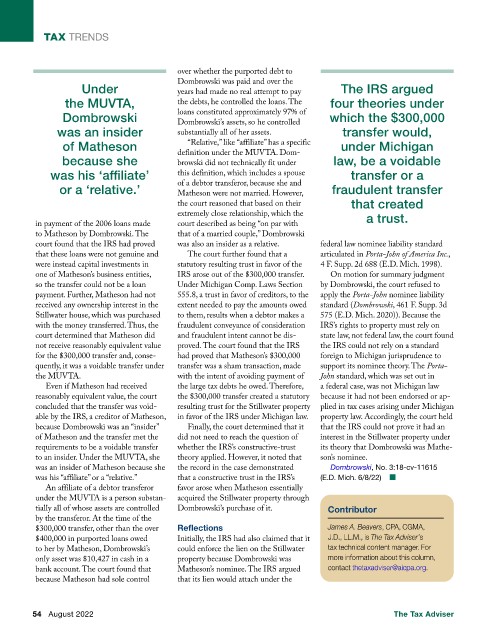Page 437 - TaxAdviser_2022
P. 437
TAX TRENDS
over whether the purported debt to
Under Dombrowski was paid and over the The IRS argued
years had made no real attempt to pay
the MUVTA, the debts, he controlled the loans. The four theories under
Dombrowski loans constituted approximately 97% of which the $300,000
Dombrowski’s assets, so he controlled
was an insider substantially all of her assets. transfer would,
of Matheson “Relative,” like “affiliate” has a specific under Michigan
because she definition under the MUVTA. Dom- law, be a voidable
browski did not technically fit under
was his ‘affiliate’ this definition, which includes a spouse transfer or a
or a ‘relative.’ of a debtor transferor, because she and fraudulent transfer
Matheson were not married. However,
that created
the court reasoned that based on their
extremely close relationship, which the a trust.
in payment of the 2006 loans made court described as being “on par with
to Matheson by Dombrowski. The that of a married couple,” Dombrowski
court found that the IRS had proved was also an insider as a relative. federal law nominee liability standard
that these loans were not genuine and The court further found that a articulated in Porta-John of America Inc.,
were instead capital investments in statutory resulting trust in favor of the 4 F. Supp. 2d 688 (E.D. Mich. 1998).
one of Matheson’s business entities, IRS arose out of the $300,000 transfer. On motion for summary judgment
so the transfer could not be a loan Under Michigan Comp. Laws Section by Dombrowski, the court refused to
payment. Further, Matheson had not 555.8, a trust in favor of creditors, to the apply the Porta-John nominee liability
received any ownership interest in the extent needed to pay the amounts owed standard (Dombrowski, 461 F. Supp. 3d
Stillwater house, which was purchased to them, results when a debtor makes a 575 (E.D. Mich. 2020)). Because the
with the money transferred. Thus, the fraudulent conveyance of consideration IRS’s rights to property must rely on
court determined that Matheson did and fraudulent intent cannot be dis- state law, not federal law, the court found
not receive reasonably equivalent value proved. The court found that the IRS the IRS could not rely on a standard
for the $300,000 transfer and, conse- had proved that Matheson’s $300,000 foreign to Michigan jurisprudence to
quently, it was a voidable transfer under transfer was a sham transaction, made support its nominee theory. The Porta-
the MUVTA. with the intent of avoiding payment of John standard, which was set out in
Even if Matheson had received the large tax debts he owed. Therefore, a federal case, was not Michigan law
reasonably equivalent value, the court the $300,000 transfer created a statutory because it had not been endorsed or ap-
concluded that the transfer was void- resulting trust for the Stillwater property plied in tax cases arising under Michigan
able by the IRS, a creditor of Matheson, in favor of the IRS under Michigan law. property law. Accordingly, the court held
because Dombrowski was an “insider” Finally, the court determined that it that the IRS could not prove it had an
of Matheson and the transfer met the did not need to reach the question of interest in the Stillwater property under
requirements to be a voidable transfer whether the IRS’s constructive-trust its theory that Dombrowski was Mathe-
to an insider. Under the MUVTA, she theory applied. However, it noted that son’s nominee.
was an insider of Matheson because she the record in the case demonstrated Dombrowski, No. 3:18-cv-11615
was his “affiliate” or a “relative.” that a constructive trust in the IRS’s (E.D. Mich. 6/8/22) ■
An affiliate of a debtor transferor favor arose when Matheson essentially
under the MUVTA is a person substan- acquired the Stillwater property through
tially all of whose assets are controlled Dombrowski’s purchase of it. Contributor
by the transferor. At the time of the
$300,000 transfer, other than the over Reflections James A. Beavers, CPA, CGMA,
$400,000 in purported loans owed Initially, the IRS had also claimed that it J.D., LL.M., is The Tax Adviser’s
to her by Matheson, Dombrowski’s could enforce the lien on the Stillwater tax technical content manager. For
only asset was $10,427 in cash in a property because Dombrowski was more information about this column,
bank account. The court found that Matheson’s nominee. The IRS argued contact thetaxadviser@aicpa.org.
because Matheson had sole control that its lien would attach under the
54 August 2022 The Tax Adviser

